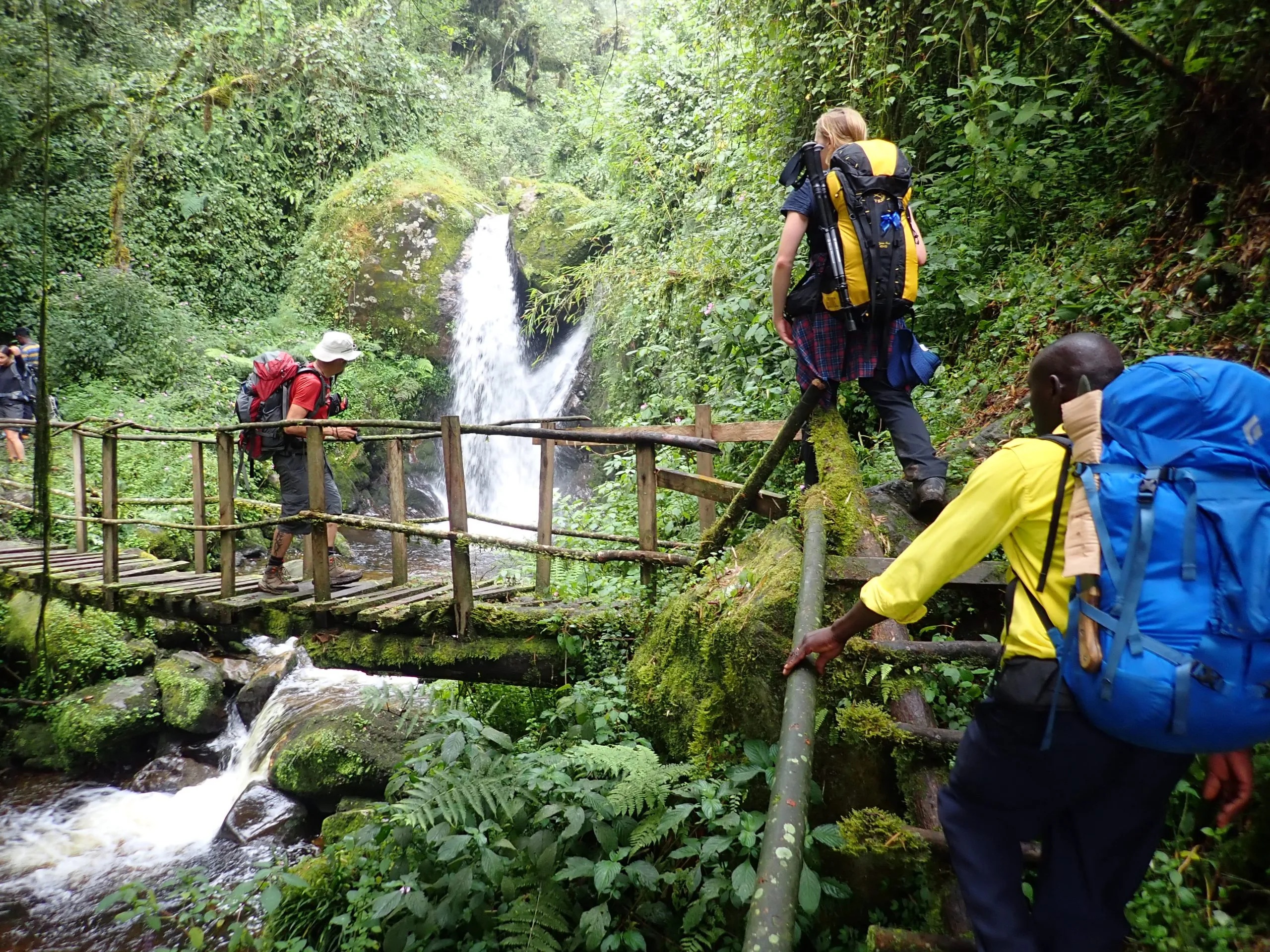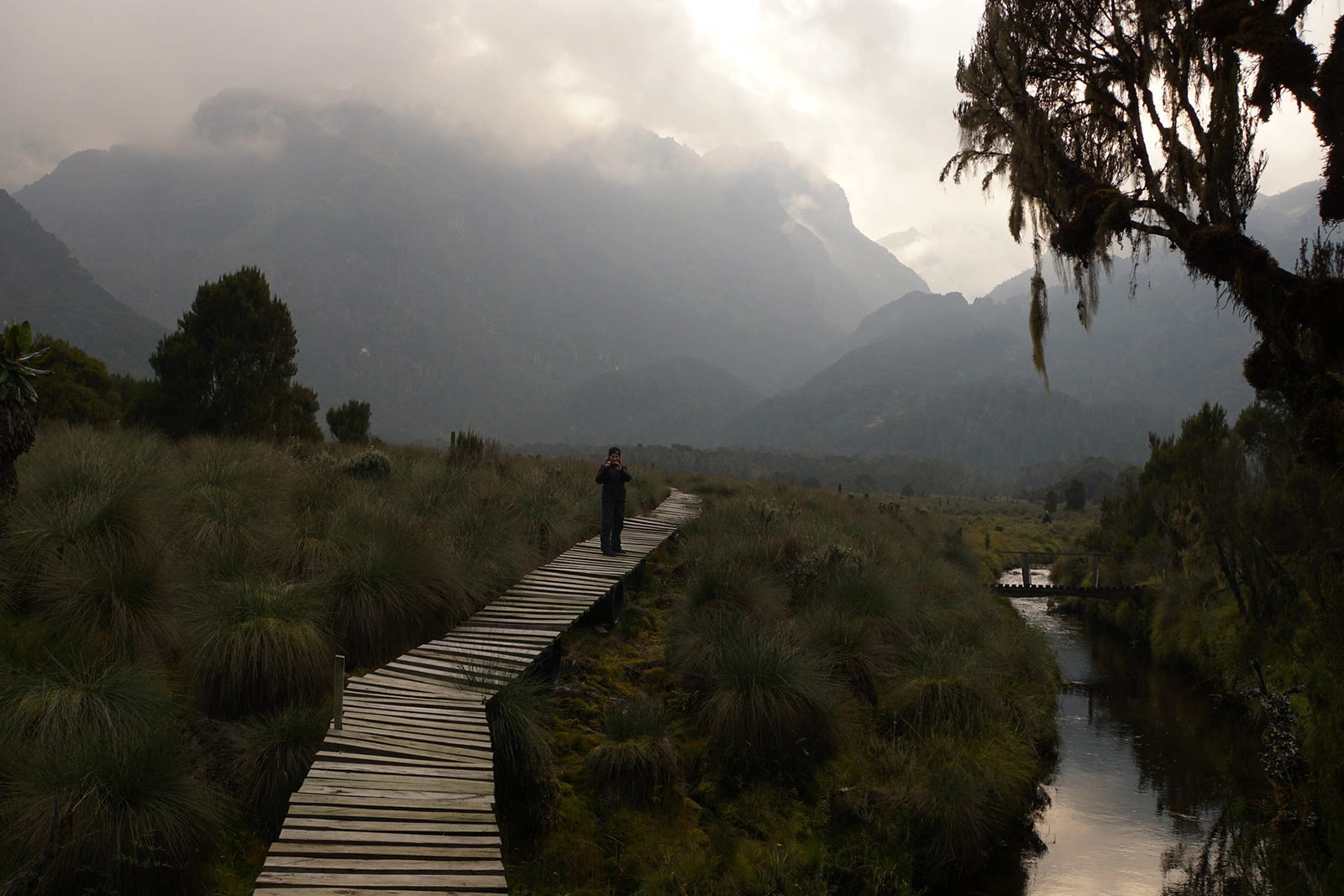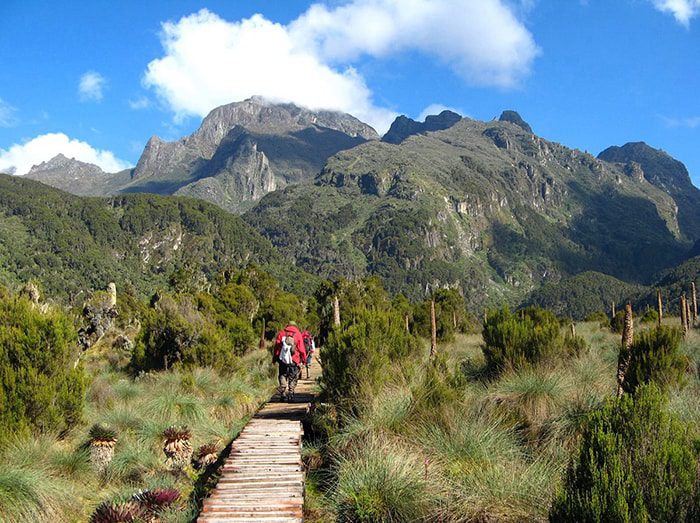At Tulambule, we are always looking for the most special and undiscovered destinations in Africa. Uganda’s Rwenzori Mountains National Park is definitely on this list! Why? The 120km long chain, known as the ‘Mountains of the Moon’, forms the largest mountain range in Africa and it is a UNESCO World Heritage Site.
Rwenzori Mountains National Park has unusual vegetation like Giant Lobelias, Giant groundsels, and beautiful everlasting flowers. There are also glacial lakes, thundering rivers and waterfalls, deep valleys, and beautiful viewpoints. This is an experience you won’t soon forget! Rwenzori has 6 peaks, all above 5000m!
Lying just 33km north of the Equator, the peaks are permanently covered with snow. And along the route, you will also encounter glaciers and hike through impressive heathland landscapes. The Margherita Peak on Mount Stanley stands at an altitude of 5,109 meters. It is the third-highest peak in Africa after Kilimanjaro and Mt Kenya but is possibly the most difficult to summit due to the very rugged nature of the terrain there.
Hiking the Rwenzori Mountains also offers a refreshing “off the beaten track” experience that complements a safari to the often hot savanna of Queen Elizabeth National Park, chimp trekking in Kibale Forest National Park, and a gorilla trek in Bwindi Impenetrable Forest National Park.
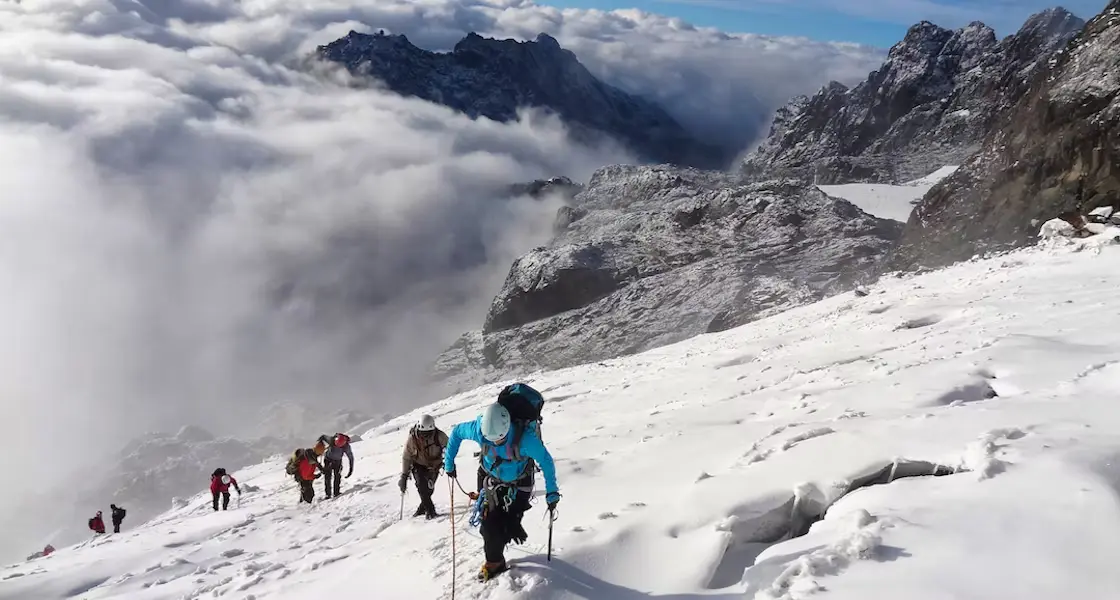
Trips To Rwenzori Mountains National Park
Climb Rwenzori Mountains, the tallest block mountain in Africa with us! We offer different trekking and climbing options! If you want to do a private tour or join the group, we would be very happy to help!
History Of Rwenzori Mountains National Park
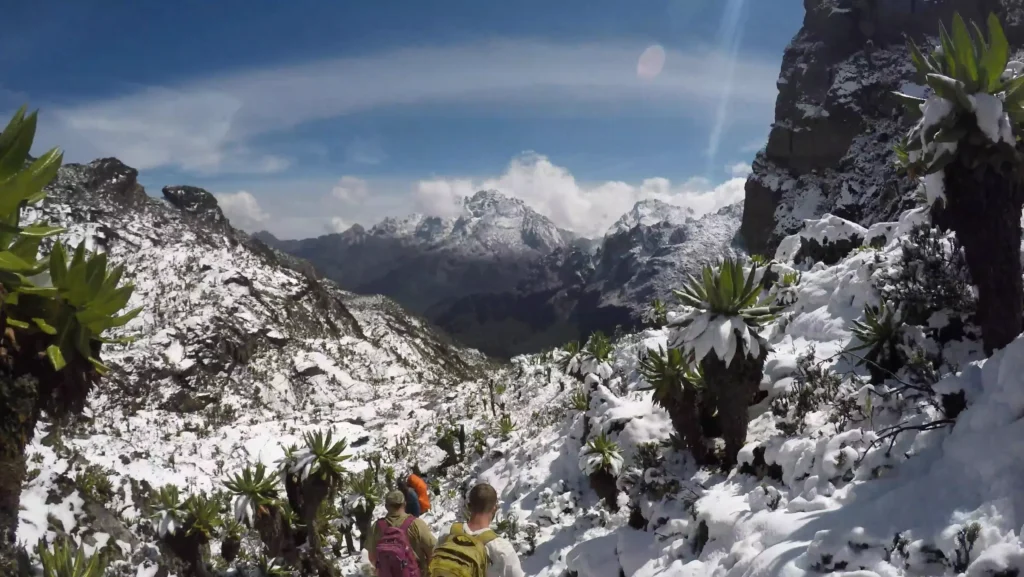
Rwenzori Mountains was gazetted as a national park in 1991 due to its unique biodiversity and the value of water flowing from its mountainsides. In 1994, UNESCO recognized the unique natural beauty and biodiversity of Rwenzori Mountain National Park and declared it a World Heritage Site.
In 2008, Rwenzori was also named a Ramsar site of International Importance for its value in the protection of wetlands. The park currently conserves nearly 1,000km² of this unique and vulnerable region with its 5 unique vegetation zones and unparalleled levels of endemic species.
The Rwenzori Mountains area has been home to many diverse people and societies for millennia. All recorgnized the value of the water flowing from the peaks and held them sacred. The Bakonzo people even named the mountains “Rainmaker”, a fitting name for what is one of Africa’s most essential water sources.
Ptolemy, the Greek-Egyptian geographer, astronomer, and mathematician, incorrectly identified the Rwenzoris as the source of River Nile, giving the range its charming nickname “Montes Lunae” or the “Mountains of the Moon”.
Not until much later was the true source discovered at Lake Victoria in Uganda. Since becoming known outside of Africa, Rwenzori Mountains region has captivated the imaginations of adventurers, explorers and scientists globally, sparking expeditions to try and unravel the mysteries and secrets of this primeval wonder.
Different Ways To Hike Rwenzori Mountains

There are so many ways you can explore the Rwenzori Mountains National Park!
1. Technical Climbing:
Possibly the most challenging and technical climbing adventure you can undertake in Africa is braving the Rwenzori Mountains and reaching the tallest peak, Margherita Peak on Mt Stanley (also known as Mount Ngaliema).
The Margherita Peak is the highest point in Uganda and the third highest point in Africa at 5109 meters (16762 feet) above sea level. It is an 8-day trek to the top with 7 nights on the mountain in simple camps.
There is professional guidance from certified mountain clmbing/trekking guides and you use complete climbing equipment. We highly recommend the acclimatization to Mutinda lookout so that you can better acclimatize to brave the high altitudes of the legendary “Mountains of the Moon”. Afterwards, you can proudly say that you have climbed the tallest mountain range on the African continent and few other people can say that!
You may also like; the best active adventure Uganda safaris
2. Non-Technical Trekking:
To conquer Margherita Peak, technical mountaineering experience is required. But if you are in good shape and prefer to avoid climbing equipment, the 5-day trek to Weismann Peak at 4,620m is highly recommended and is the most popular route. It is a good alternative for people who want to discover the beautiful landscapes of the mountain massif but do not want to do too difficult a trek to the top.
There is professional guidance from porters, and guides and the cook prepares tasty and nutritious meals. With an acclimatization day, this trekking adventure has a good chance of reaching the top of Weismann’s peak. It is an adventure experience you will never forget and completely off the beaten track
3. Day Hikes
These lush green foothills of Rwenzori offer an ideal introduction to the incredible landscape of the Rwenzori Mountains. One trail to the south of the Rwenzori mountain range takes you along the Muyambuli River through pristine rainforest. Bird lovers can spot many endemic species, such as the rare Rwenzori Turaco, Archer’s robin-chat, and Blue-headed sunbird. This walk takes about 6 hours, with a delicious lunch provided along the way.
Other short hikes pass through villages on the northern side of the Rwenzoris, ideal for deep cultural interaction. You can participate in cultural activities, such as traditional dances, storytelling sessions, and visits to local villages. This will help you gain a deeper appreciation for the Rwenzori region’s heritage while contributing to the livelihoods of the local people who protect this environment. What are your interests? Let us know!
You may also like: 13 Best Day Hikes in Uganda anyone can do
What To Expect On A Rwenzori Mountains Hike?
- English-speaking, certified mountain guides accompany hikers, trekkers, and climbers, while handpicked porters carry equipment and belongings.
- Multi-day Rwenzori Mountains treks can be demanding, mainly due to steep paths and very wet terrain.
- On the mountain, hikers sleep in simple mountain huts and enjoy hot, tasty meals every night.
- Acclimatization is vital for altitude hiking and can affect anyone, regardless of fitness level. We have measures in place to help you combat it.
Best Time To Hike Rwenzori Mountains
June to August and December to February are the perfect time to hike in the Rwenzori Mountains; otherwise, they can be visited throughout the year. If you are a mountaineer the climbing window from June to August is the best time to attempt an ascent to Margherita Peak. Luckily for those of us who don’t like crowds, Rwenzori is never very busy. You cannot even really speak of a ‘peak season’. So feel free to book a trek in one of the drier seasons without worrying about overly busy trails. You may also like; the best time to visit Uganda
FAQs About Rwenzori Mountains National Park
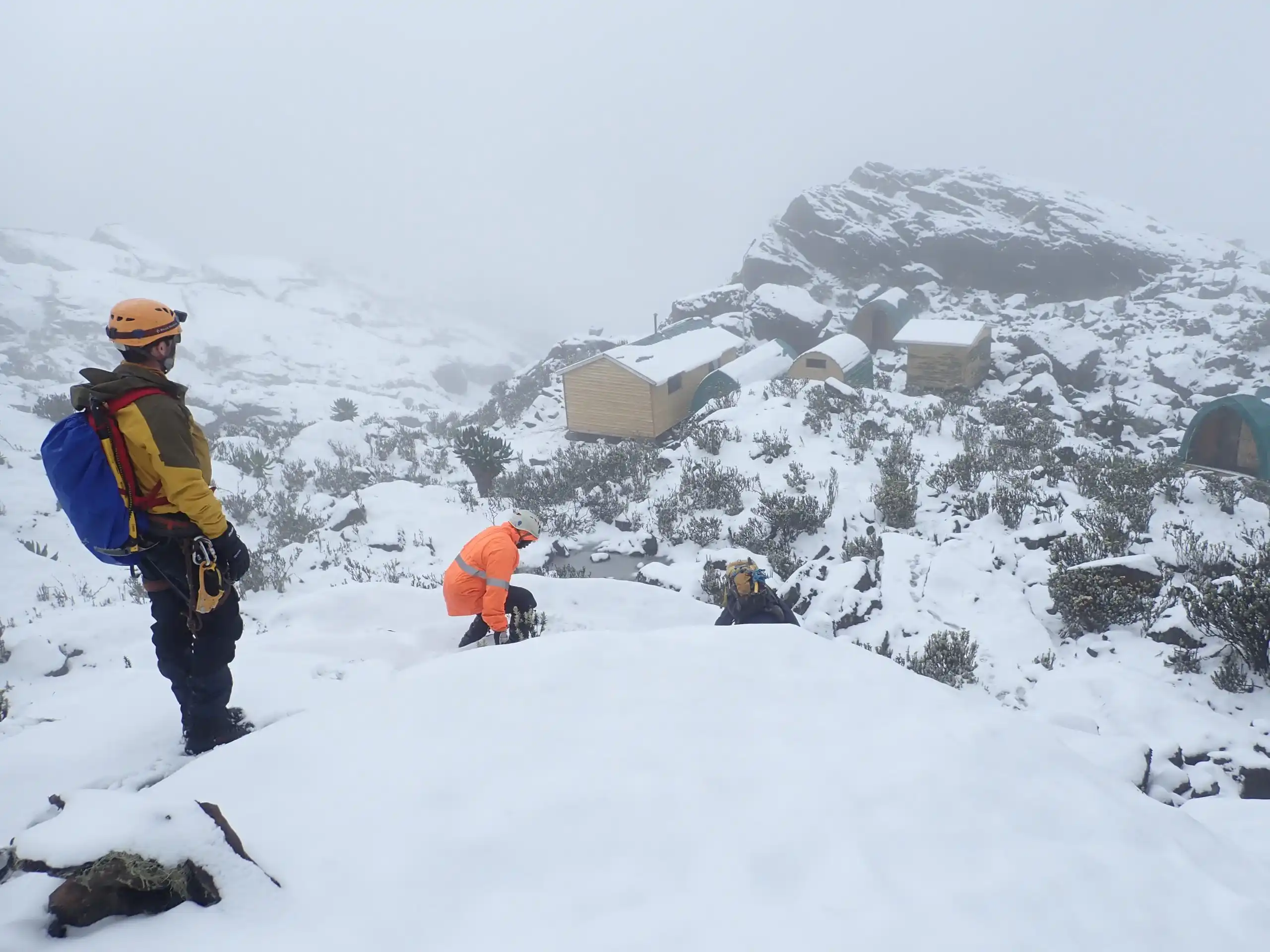
1. What Does Rwenzori Mean?
The name Rwenzori comes from rwe nzururu, which means “place of snow” in the local Lukonzo language. The local Bakonzo people who live in the foothills of the mountains have a very strong attachment to the snow and the water of Rwenzori Mountains National Park. They believe that their god, Kitasamba, lives at the top of the mountain in the snow and that the snow is actually the frozen sperm of their god.
2. What Is The Nickname Of The Rwenzori Mountains?
The nickname of the Rwenzori Mountains is “Mountains of the Moon”. Ptolemy, the Greek-Egyptian astronomer, mathematician, and geographer, incorrectly identified the Rwenzori Mountains as the source of River Nile, giving the range this charming nickname “Montes Lunae” or the “Mountains of the Moon”. Not until much later was the true source of River Nile discovered at Lake Victoria (Africa’s largest lake) in Uganda.
3. How Long Does It Take To Hike Rwenzori?
Very experienced climbers can do the trek to the highest peak in 7 days and the less experienced or first-timers are recommended to do the trek in 9 days. Eight (8) days is recommended for those with some experience but not ready to do the trek in 7 days.
4. How Much Does It Cost To Climb Rwenzori?
The cost of hiking the Rwenzori Mountains in Uganda depends on the number of people in a trekking group as well as the number of days decided upon for trekking. The complete experience costs approximately $2500 per person. That amount includes the permit, porters, meals, and the accommodation.
5. How Do I Get To The Rwenzori Mountains?
The Rwenzori Mountains can be reached by two routes from Kampala to Kasese. The shortest route starts from Kampala to Fort Portal via Mubende for a distance of 300 kilometers by a 4×4, while the longest route begins from Kampala, via Masaka through Mbarara, Bushenyi to Kasese for 350 kilometer distance drive.
Want To Visit Rwenzori Mountains National Park?

The Rwenzori Mountains National Park in Uganda is an enchanting world where nature’s wonders are magnificently displayed. From the snow-capped peaks to the unique plants, every facet of this extraordinary landscape beckons travelers to embark on a remarkable life-altering journey. For information about the different hiking routes and options available, CONTACT US. For quick information, you can WHATSAPP US.


